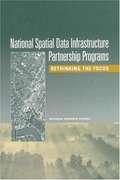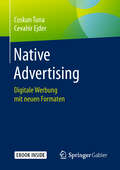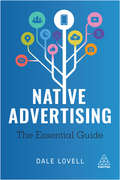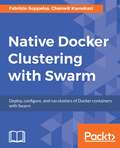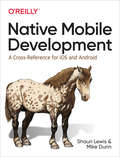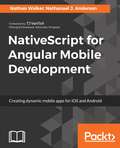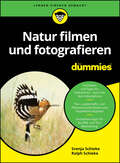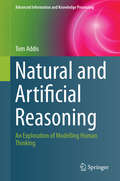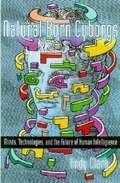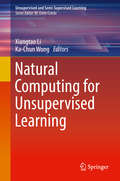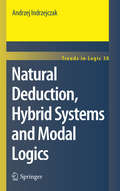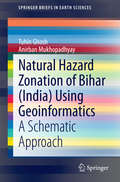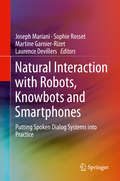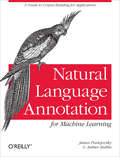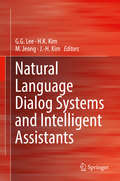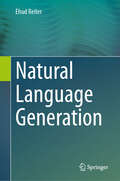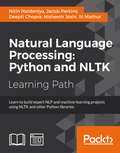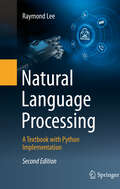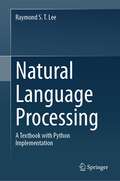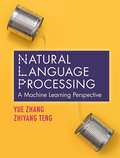- Table View
- List View
National Security Research on the Internet
by William M. ArkinGuide to research on the internet on national security issues.
National Spatial Data Infrastructure Partnership Programs: Rethinking the Focus
by National Research CouncilThe National Academies Press (NAP)--publisher for the National Academies--publishes more than 200 books a year offering the most authoritative views, definitive information, and groundbreaking recommendations on a wide range of topics in science, engineering, and health. Our books are unique in that they are authored by the nation's leading experts in every scientific field.
Native Ads
by Brian GravesBasically, what we are doing in this special method is that we send cheap traffic to simple domains we own that have sponsored ads on them. How do we get the ads on the domains? We simply park the domain with a provider that will put the ads on our domain automatically.
Native Advertising: Digitale Werbung Mit Nativen Kampagnen
by Cevahir Ejder Coskun TunaDieses Buch erklärt kompakt und auf den Punkt, was Native Advertising ist, wie diese neue Werbedisziplin funktioniert und welche Vorteile sie Werbungtreibenden bietet. Die Autoren – selber Vorreiter in dieser jungen Branche – geben einen aktuellen Überblick mit wichtigen Daten und Fakten, erklären alle nativen Werbeformate im Detail und beschreiben die Technologien sowie die durchaus kontrovers diskutierten Rollen der einzelnen Player dabei: Publisher, Advertiser und Konsumenten.Ein Praxisleitfaden für alle, die an Online-Werbung jenseits von Bannern und Rectangles interessiert sind, um ihren Produkten mit sensibel gestalteten und gut ausgesteuerten nativen Kampagnen mehr Glaubwürdigkeit und Sympathie zu verleihen.
Native Advertising: The Essential Guide
by Dale LovellNative advertising: paid-for media that looks and behaves like the content around it. It affects us all. If you own a smartphone, use social media or read content online, you will have been exposed to it - often without realizing. Influenced by digital trends such as mobile advertising, programmatic advertising, ad-blocking, fake news and artificial intelligence, native advertising is a multibillion-dollar industry. It is central to the digital success of many leading brands and companies.This comprehensive study by one of the industry's foremost authorities explores the rise of this exhilarating new channel - its impact on the digital media space, and what marketers and businesses need to know about it. This book explores the future of digital advertising and explains why its growth is inevitable, using real-life examples and interviews from marketing leaders around the world and a range of case studies including The New York Times and The Independent.Native Advertising goes beyond sponsored posts on Facebook, promoted tweets and BuzzFeed branded articles. It looks at the heart of the matter: audience, budget, content and success measurement. It is full of first-hand advice for any marketer wanting to make the most of digital innovation.
Native Docker Clustering with Swarm
by Chanwit Kaewkasi Fabrizio SoppelsaDeploy, configure, and run clusters of Docker containers with Swarm About This Book • Get to grips with Docker Swarm, one of the key components of the Docker ecosystem. • Optimize Swarm and SwarmKit features for scaling massive applications through containers. • Learn about Docker's scheduling tricks, high availability, security, and platform scalability. Who This Book Is For If you are a Linux admin or a Docker user who wants to natively manage Docker clusters, then this is the book for you. What You Will Learn • Create and manage Swarm Mode clusters of any size • Get a backstage view of the biggest Swarms ever built : Swarm2k and Swarm3k, with their 2,300 and 4,700 nodes • Discovery mechanisms and Raft • Deploy your containerized app on Swarm • Administer Swarm clusters on AWS, Azure, and DigitalOcean • Integrate Flocker volumes with Swarm • Create and manage Swarms on OpenStack Magnum In Detail Docker Swarm serves as one of the crucial components of the Docker ecosystem and offers a native solution for you to orchestrate containers. It's turning out to be one of the preferred choices for Docker clustering thanks to its recent improvements. This book covers Swarm, Swarm Mode, and SwarmKit. It gives you a guided tour on how Swarm works and how to work with Swarm. It describes how to set up local test installations and then moves to huge distributed infrastructures. You will be shown how Swarm works internally, what's new in Swarmkit, how to automate big Swarm deployments, and how to configure and operate a Swarm cluster on the public and private cloud. This book will teach you how to meet the challenge of deploying massive production-ready applications and a huge number of containers on Swarm. You'll also cover advanced topics that include volumes, scheduling, a Libnetwork deep dive, security, and platform scalability. Style and approach A comprehensive guide that covers all aspects of Docker Swarm from setup to customization.
Native Mobile Development: A Cross-Reference for iOS and Android
by Shaun Lewis Mike DunnLearn how to make mobile native app development easier. If your team frequently works with both iOS and Android—or plans to transition from one to the other—this hands-on guide shows you how to perform the most common development tasks in each platform. Want to learn how to make network connections in iOS? Or how to work with a database in Android? This book has you covered.In the book’s first part, authors Shaun Lewis and Mike Dunn from O’Reilly’s mobile engineering group provide a list of common, platform-agnostic tasks. The second part helps you create a bare-bones app in each platform, using the techniques from part one.Common file and database operationsNetwork communication with remote APIsApplication lifecycleCustom views and componentsThreading and asynchronous workUnit and integration testsConfiguring, building, and running an app on a device
NativeScript for Angular Mobile Development
by Nathan Walker Nathanael J. AndersonLearn NativeScript to build native mobile applications with Angular, TypeScript, JavaScript About This Book • Power packed hands-on guide to help you become pro-efficient with NativeScript • Harness the power of your web development skills with JavaScript and Angular to build cross-platform mobile apps • Create highly maintainable and feature-rich apps with TypeScript and NativeScript APIs Who This Book Is For This book assumes you have a general understanding of TypeScript, have heard of NativeScript and know what it's about, and are familiar with Angular (2.0). You don't need to be an expert in any of these technologies, but having some sense of them before reading is recommended this book, which is ideal for intermediate to advanced users. What You Will Learn • Bootstrap a NativeScript for Angular app • Best practices for project organization • Style your app with CSS/SASS • Use Angular together with NativeScript to create cross-platform mobile apps • Take advantage of powerful Angular features, such as Dependency Injection, Components, Directives, Pipes, and NgModules right within your NativeScript apps •Gain insight into great project organization and best practices •Use Objective C/Swift and Java APIs directly from TypeScript •Use rich framework features and third-party plugins •Style your app with CSS/SASS •Integrate @ngrx/store + @ngrx/effects to help with state management •Test your app with Karma and Appium In Detail NativeScript is an open source framework that is built by Progress in order to build truly native mobile apps with TypeScript, JavaScript or just Angular which is an open source framework built by Google that offers declarative templates, dependency injection, and fully featured modules to build rich applications. Angular's versatile view handling architecture allows your views to be rendered as highly performant UI components native to iOS and Android mobile platforms. This decoupling of the view rendering layer in Angular combined with the power of native APIs with NativeScript have together created the powerful and exciting technology stack of NativeScript for Angular. This book focuses on the key concepts that you will need to know to build a NativeScript for Angular mobile app for iOS and Android. We'll build a fun multitrack recording studio app, touching on powerful key concepts from both technologies that you may need to know when you start building an app of your own. The structure of the book takes the reader from a void to a deployed app on both the App Store and Google Play, serving as a reference guide and valuable tips/tricks handbook. By the end of this book, you'll know majority of key concepts needed to build a successful NativeScript for Angular app. Style and approach This step-by-step advanced tutorial focuses on the key concepts you need to know to build a NativeScript for Angular mobile app for iOS and Android.
Natur filmen und fotografieren für Dummies (Für Dummies)
by Svenja Schieke Ralph SchiekeFangen Sie spannende Motive in der Natur ein – mit Ihrer Kamera Schon mit wenig Ausrüstung können Sie wunderbare Momente festhalten – nicht nur in Einzelbildern, sondern auch im Film. Wie Sie Landschaften und Tiere filmen und fotografieren, lernen Sie in diesem Buch. Svenja und Ralph Schieke zeigen Ihnen Schritt für Schritt von der Planung bis zur Veröffentlichung, wie spannende und interessante Naturfotografien und Naturfilme mit dem gewissen Etwas entstehen. Sie erfahren, wie Sie Motive finden, welche Ausrüstung Sie benötigen, was Sie bei den Aufnahmen beachten müssen und wie Sie Ihre Ergebnisse weiter bearbeiten. Sie erfahren Wie Sie auch mit Ihrem Smartphone gelungene Aufnahmen machen Warum sich die Stadt nicht verstecken muss, wenn es um Naturaufnahmen gehtWie Sie einen Film planen und in der Natur Schritt für Schritt umsetzenWo Sie Ihre Aufnahmen präsentieren können
Natural and Artificial Reasoning
by Tom AddisWhat are the limitations of computer models and why do we still not have working models of people that are recognizably human? This is the principle puzzle explored in this book where ideas behind systems that behave intelligently are described and different philosophical issues are touched upon. The key to human behavior is taken to be intelligence and the ability to reason about the world. A strong scientific approach is taken, but first it was required to understand what a scientific approach could mean in the context of both natural and artificial systems. A theory of intelligence is proposed that can be tested and developed in the light of experimental results. The book illustrates that intelligence is much more than just behavior confined to a unique person or a single computer program within a fixed time frame. Some answers are unraveled and some puzzles emerge from these investigations and experiments. Natural and Artificial Reasoning provides a few steps of an exciting journey that began many centuries ago with the word 'why?'
Natural-Born Cyborgs: Minds, Technologies, and the Future of Human Intelligence
by Andrew J. ClarkCognitive scientist Clark believes we are liberating our minds, thanks to our penchant for inventing tools that extend our abilities to think and communicate, starting with the basics of pen and paper and moving on to ever more sophisticated forms of computers. In this lively and provocative treatise, Clark declares that we are, in fact, "human-technology symbionts" or "natural-born cyborgs," always seeking ways to enhance our biological mental capacities through technology, an intriguing claim he supports with a brisk history of "biotechnology mergers," which currently range from pacemakers to the way a pilot of a commercial airplane is but one component in an elaborate "biotechnological problem-solving matrix." Cell phones, Clark explains, are "a prime, if entry-level cyborg technology," as are Internet search engines. As Clark clearly and cheerfully discusses cognitive processes, how we build "better worlds to think in," opaque versus transparent technologies, and the fluidity of our sense of self and adaptation to environmental changes, he offers hope that our brainy species can use its ever-evolving
Natural Computing for Unsupervised Learning (Unsupervised and Semi-Supervised Learning)
by Xiangtao Li Ka-Chun WongThis book highlights recent research advances in unsupervised learning using natural computing techniques such as artificial neural networks, evolutionary algorithms, swarm intelligence, artificial immune systems, artificial life, quantum computing, DNA computing, and others. The book also includes information on the use of natural computing techniques for unsupervised learning tasks. It features several trending topics, such as big data scalability, wireless network analysis, engineering optimization, social media, and complex network analytics. It shows how these applications have triggered a number of new natural computing techniques to improve the performance of unsupervised learning methods. With this book, the readers can easily capture new advances in this area with systematic understanding of the scope in depth. Readers can rapidly explore new methods and new applications at the junction between natural computing and unsupervised learning. Includes advances on unsupervised learning using natural computing techniquesReports on topics in emerging areas such as evolutionary multi-objective unsupervised learning Features natural computing techniques such as evolutionary multi-objective algorithms and many-objective swarm intelligence algorithms
Natural Deduction, Hybrid Systems and Modal Logics
by Andrzej IndrzejczakThis book provides a detailed exposition of one of the most practical and popular methods of proving theorems in logic, called Natural Deduction. It is presented both historically and systematically. Also some combinations with other known proof methods are explored. The initial part of the book deals with Classical Logic, whereas the rest is concerned with systems for several forms of Modal Logics, one of the most important branches of modern logic, which has wide applicability.
Natural Hazard Zonation of Bihar (India) Using Geoinformatics
by Tuhin Ghosh Anirban MukhopadhyayWith increased climate variability, aggravated natural hazards in the form of extreme events are affecting the lives and livelihoods of many people. This work serves as a basis for formulating a 'preparedness plan' to ensure the effective policy formulation for planned development. Increased demand and competition with a high degree of variability have forced people to struggle in order to prosper. Good governance and innovative policy formulation are necessary to create a resilient society. This may promote a paradigm shift in the mindset on and perceptions of natural hazards and their impacts on development and growth. This new perspective will make people more concerned about minimizing the loss of life, property, and environmental damage and directly safeguard the development process. This book presents a detailed methodological approach to monitoring meteorological, hydrological, and climate change aspects to help resolve issues related to our environment, resources, and economies in the changing climate situation.
Natural Interaction with Robots, Knowbots and Smartphones
by Joseph Mariani Sophie Rosset Martine Garnier-Rizet Laurence DevillersThese proceedings presents the state-of-the-art in spoken dialog systems with applications in robotics, knowledge access and communication. It addresses specifically: 1. Dialog for interacting with smartphones; 2. Dialog for Open Domain knowledge access; 3. Dialog for robot interaction; 4. Mediated dialog (including crosslingual dialog involving Speech Translation); and,5. Dialog quality evaluation. These articles were presented at the IWSDS 2012 workshop.
Natural Language Analytics with Generative Large-Language Models: A Practical Approach with Ollama and Open-Source LLMs (SpringerBriefs in Computer Science)
by Francisco S. Marcondes Adelino Gala Renata Magalhães Fernando Perez de Britto Dalila Durães Paulo NovaisThis book explores the application of generative Large Language Models (LLMs) for extracting and analyzing data from natural language artefacts. Unlike traditional uses of LLMs, such as translation and summarization, this book focuses on utilizing these models to convert unstructured text into data that can be processed through the data science pipeline to generate actionable insights. The content is designed for professionals in diverse fields including cognitive science, linguistics, management, and information systems. It combines insights from both industry and academia to provide a comprehensive understanding of how LLMs can be effectively used for natural language analytics (NLA). The book details practical methodologies for implementing LLMs locally using open-source tools, ensuring data privacy and feasibility without the need for expensive infrastructure. Key topics include interpretant, mindset and cultural analysis, emphasizing the use of LLMs to derive soft data—qualitative information crucial for nuanced decision-making. The text also outlines the technical aspects of LLMs, including their architecture, token embeddings, and the differences between encoder-based and decoder-based models. By providing a case study and practical examples, the authors show how LLMs can be used to meet various analytical needs, making this book a valuable resource for anyone looking to integrate advanced natural language processing techniques into their data analysis workflows.
Natural Language Annotation for Machine Learning: A Guide to Corpus-Building for Applications
by James Pustejovsky Amber StubbsCreate your own natural language training corpus for machine learning. Whether you’re working with English, Chinese, or any other natural language, this hands-on book guides you through a proven annotation development cycle—the process of adding metadata to your training corpus to help ML algorithms work more efficiently. You don’t need any programming or linguistics experience to get started.Using detailed examples at every step, you’ll learn how the MATTER Annotation Development Process helps you Model, Annotate, Train, Test, Evaluate, and Revise your training corpus. You also get a complete walkthrough of a real-world annotation project.Define a clear annotation goal before collecting your dataset (corpus)Learn tools for analyzing the linguistic content of your corpusBuild a model and specification for your annotation projectExamine the different annotation formats, from basic XML to the Linguistic Annotation FrameworkCreate a gold standard corpus that can be used to train and test ML algorithmsSelect the ML algorithms that will process your annotated dataEvaluate the test results and revise your annotation taskLearn how to use lightweight software for annotating texts and adjudicating the annotationsThis book is a perfect companion to O’Reilly’s Natural Language Processing with Python.
Natural Language Dialog Systems and Intelligent Assistants
by Ji-Hwan Kim Minwoo Jeong Hong Kook Kim Gary Geunbae LeeThis book covers state-of-the-art topics on the practical implementation of Spoken Dialog Systems and intelligent assistants in everyday applications. It presents scientific achievements in language processing that result in the development of successful applications and addresses general issues regarding the advances in Spoken Dialog Systems with applications in robotics, knowledge access and communication. Emphasis is placed on the following topics: speaker/language recognition, user modeling / simulation, evaluation of dialog system, multi-modality / emotion recognition from speech, speech data mining, language resource and databases, machine learning for spoken dialog systems and educational and healthcare applications.
Natural Language Generation
by Ehud ReiterIn late 2022, the prominence of Natural Language Generation (NLG) surged with the advent of advanced language models like ChatGPT. While these developments have captivated both academic and commercial sectors, the focus has predominantly been on the latest innovations, often overlooking the rich history and foundational work in NLG. This book aims to provide a comprehensive overview of NLG, encompassing not only language models but also alternative approaches, user requirements, evaluation methods, safety and testing protocols, and practical applications. Drawing on decades of NLG research, the book is designed to be a valuable resource for both researchers and developers, offering insights that remain relevant far beyond the current technological landscape. Natural Language Generation focuses on data-to-text but also looks at other types of NLG including text summarization. The book takes a holistic approach to NLG, looking at requirements (what users are looking for), design, data issues, testing, evaluation, safety and ethical issues as well as technology. The holistic approach is unique to this book and is very valuable for people building real-world NLG systems, and for academics and researchers who are interested in applied NLG. The author, who previously co-authored a seminal NLG book in 2000, emphasizes high-level concepts and methodologies, ensuring the material's longevity and utility. The book is structured to balance technical depth with practical relevance, including chapters on rule-based and neural NLG approaches, user requirements, rigorous evaluation techniques, and safety considerations. Real-world applications, particularly in journalism, business intelligence, summarization, and medicine, are explored to illustrate NLG's potential and scalability. With personal anecdotes and examples from the author's experiences, this book provides a unique and engaging perspective on the evolving field of NLG, making it an indispensable guide for those looking to harness the power of language generation technologies.
Natural Language Generation in Interactive Systems
by Amanda Stent Srinivas BangaloreAn informative and comprehensive overview of the state-of-the-art in natural language generation (NLG) for interactive systems, this guide serves to introduce graduate students and new researchers to the field of natural language processing and artificial intelligence, while inspiring them with ideas for future research. Detailing the techniques and challenges of NLG for interactive applications, it focuses on the research into systems that model collaborativity and uncertainty, are capable of being scaled incrementally, and can engage with the user effectively. A range of real-world case studies is also included. The book and the accompanying website feature a comprehensive bibliography, and refer the reader to corpora, data, software and other resources for pursuing research on natural language generation and interactive systems, including dialog systems, multimodal interfaces and assistive technologies. It is an ideal resource for students and researchers in computational linguistics, natural language processing and related fields.
Natural Language Interfaces to Databases (Synthesis Lectures on Data Management)
by Yunyao Li Dragomir Radev Davood RafieiThis book presents a comprehensive overview of Natural Language Interfaces to Databases (NLIDBs), an indispensable tool in the ever-expanding realm of data-driven exploration and decision making. After first demonstrating the importance of the field using an interactive ChatGPT session, the book explores the remarkable progress and general challenges faced with real-world deployment of NLIDBs. It goes on to provide readers with a holistic understanding of the intricate anatomy, essential components, and mechanisms underlying NLIDBs and how to build them. Key concepts in representing, querying, and processing structured data as well as approaches for optimizing user queries are established for the reader before their application in NLIDBs is explored. The book discusses text to data through early relevant work on semantic parsing and meaning representation before turning to cutting-edge advancements in how NLIDBs are empowered to comprehend and interpret human languages. Various evaluation methodologies, metrics, datasets and benchmarks that play a pivotal role in assessing the effectiveness of mapping natural language queries to formal queries in a database and the overall performance of a system are explored. The book then covers data to text, where formal representations of structured data are transformed into coherent and contextually relevant human-readable narratives. It closes with an exploration of the challenges and opportunities related to interactivity and its corresponding techniques for each dimension, such as instances of conversational NLIDBs and multi-modal NLIDBs where user input is beyond natural language. This book provides a balanced mixture of theoretical insights, practical knowledge, and real-world applications that will be an invaluable resource for researchers, practitioners, and students eager to explore the fundamental concepts of NLIDBs.
Natural Language Processing: Python and NLTK
by Nitin Hardeniya Nisheeth Joshi Jacob Perkins Iti Mathur Deepti ChopraLearn to build expert NLP and machine learning projects using NLTK and other Python libraries About This Book * Break text down into its component parts for spelling correction, feature extraction, and phrase transformation * Work through NLP concepts with simple and easy-to-follow programming recipes * Gain insights into the current and budding research topics of NLP Who This Book Is For If you are an NLP or machine learning enthusiast and an intermediate Python programmer who wants to quickly master NLTK for natural language processing, then this Learning Path will do you a lot of good. Students of linguistics and semantic/sentiment analysis professionals will find it invaluable. What You Will Learn * The scope of natural language complexity and how they are processed by machines * Clean and wrangle text using tokenization and chunking to help you process data better * Tokenize text into sentences and sentences into words * Classify text and perform sentiment analysis * Implement string matching algorithms and normalization techniques * Understand and implement the concepts of information retrieval and text summarization * Find out how to implement various NLP tasks in Python In Detail Natural Language Processing is a field of computational linguistics and artificial intelligence that deals with human-computer interaction. It provides a seamless interaction between computers and human beings and gives computers the ability to understand human speech with the help of machine learning. The number of human-computer interaction instances are increasing so it's becoming imperative that computers comprehend all major natural languages. The first NLTK Essentials module is an introduction on how to build systems around NLP, with a focus on how to create a customized tokenizer and parser from scratch. You will learn essential concepts of NLP, be given practical insight into open source tool and libraries available in Python, shown how to analyze social media sites, and be given tools to deal with large scale text. This module also provides a workaround using some of the amazing capabilities of Python libraries such as NLTK, scikit-learn, pandas, and NumPy. The second Python 3 Text Processing with NLTK 3 Cookbook module teaches you the essential techniques of text and language processing with simple, straightforward examples. This includes organizing text corpora, creating your own custom corpus, text classification with a focus on sentiment analysis, and distributed text processing methods. The third Mastering Natural Language Processing with Python module will help you become an expert and assist you in creating your own NLP projects using NLTK. You will be guided through model development with machine learning tools, shown how to create training data, and given insight into the best practices for designing and building NLP-based applications using Python. This Learning Path combines some of the best that Packt has to offer in one complete, curated package and is designed to help you quickly learn text processing with Python and NLTK. It includes content from the following Packt products: * NTLK essentials by Nitin Hardeniya * Python 3 Text Processing with NLTK 3 Cookbook by Jacob Perkins * Mastering Natural Language Processing with Python by Deepti Chopra, Nisheeth Joshi, and Iti Mathur Style and approach This comprehensive course creates a smooth learning path that teaches you how to get started with Natural Language Processing using Python and NLTK. You'll learn to create effective NLP and machine learning projects using Python and NLTK.
Natural Language Processing: A Textbook with Python Implementation
by Raymond LeeThis textbook provides a contemporary and comprehensive overview of Natural Language Processing (NLP), covering fundamental concepts, core algorithms, and key applications such as AI chatbots, Large Language Models and Generative AI. Additionally, it includes seven step-by-step NLP workshops, totaling 14 hours, that offer hands-on practice with essential Python tools, including NLTK, spaCy, TensorFlow, Keras, Transformers, and BERT. The objective of this book is to provide readers with a fundamental grasp of NLP and its core technologies, and to enable them to build their own NLP applications (e.g. Chatbot systems) using Python-based NLP tools. It is both a textbook and NLP tool-book intended for the following readers: undergraduate students from various disciplines who want to learn NLP; lecturers and tutors who want to teach courses or tutorials for undergraduate/graduate students on NLP and related AI topics; and readers with various backgrounds who want to learn NLP, and more importantly, to build workable NLP applications after completing its 14 hours of Python-based workshops.
Natural Language Processing: A Textbook with Python Implementation
by Raymond S. LeeThis textbook presents an up-to-date and comprehensive overview of Natural Language Processing (NLP), from basic concepts to core algorithms and key applications. Further, it contains seven step-by-step NLP workshops (total length: 14 hours) offering hands-on practice with essential Python tools like NLTK, spaCy, TensorFlow Kera, Transformer and BERT.The objective of this book is to provide readers with a fundamental grasp of NLP and its core technologies, and to enable them to build their own NLP applications (e.g. Chatbot systems) using Python-based NLP tools. It is both a textbook and NLP tool-book intended for the following readers: undergraduate students from various disciplines who want to learn NLP; lecturers and tutors who want to teach courses or tutorials for undergraduate/graduate students on NLP and related AI topics; and readers with various backgrounds who want to learn NLP, and more importantly, to build workable NLP applications after completing its 14 hours of Python-based workshops.
Natural Language Processing: A Machine Learning Perspective
by Yue Zhang Zhiyang TengWith a machine learning approach and less focus on linguistic details, this gentle introduction to natural language processing develops fundamental mathematical and deep learning models for NLP under a unified framework. NLP problems are systematically organised by their machine learning nature, including classification, sequence labelling, and sequence-to-sequence problems. Topics covered include statistical machine learning and deep learning models, text classification and structured prediction models, generative and discriminative models, supervised and unsupervised learning with latent variables, neural networks, and transition-based methods. Rich connections are drawn between concepts throughout the book, equipping students with the tools needed to establish a deep understanding of NLP solutions, adapt existing models, and confidently develop innovative models of their own. Featuring a host of examples, intuition, and end of chapter exercises, plus sample code available as an online resource, this textbook is an invaluable tool for the upper undergraduate and graduate student.

